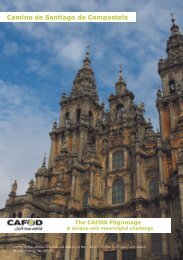Religious Education Curriculum Directory (3-19) - The Catholic ...
Religious Education Curriculum Directory (3-19) - The Catholic ...
Religious Education Curriculum Directory (3-19) - The Catholic ...
- No tags were found...
Create successful ePaper yourself
Turn your PDF publications into a flip-book with our unique Google optimized e-Paper software.
<strong>Catholic</strong> Bishops’ Conference of England and Wales — Department of <strong>Catholic</strong> <strong>Education</strong> and Formation14 – <strong>19</strong>Teaching and learning strategies which enablepupils to develop knowledge and understanding tocritically analyse, evaluate and show a coherent understandingof:Revelation• the Church’s teaching about God as One andTrinity: its biblical roots, the formation ofcreedal statements and their implicationsfor the Christian life;• the Church’s teaching about God’s power andProvidence in cre ation and the problem ofevil;• the Church’s teaching about faith (e.g. gift,virtue) and the place of reason in the searchfor God;• the human experience of faith, faithfulnessand the challenge of commitment;• the sources of strength and weakness, unityand conflict in the pupils them selves, in societyand in the Church;• the Church’s teaching on inspiration and theformation of the canon of Scripture;• the variety of biblical translations and aspectsof the history and practice of theChurch’s use of Scripture;• the literary forms which influence teachingand learning about faith;• the Church’s teaching and faith in JesusChrist: as fulfilment of the Old Testament; asproclaimed and witnessed to in the New Testament;as proclaimed and witnessed to inthe life of the Church which looks forward toand prepares for his coming in glory;• the names and titles given to and used byJesus of himself;• the Church’s teaching on the Holy Spiritin the life of the Church and the individualChristian;• the Church’s teaching on respect for thework of the Holy Spirit in all people.<strong>The</strong> Church• the key symbols used by the Church in Scriptureand Tradition;• the significance of these symbols as expressionsof faith;• the implications of these symbols for theChurch’s role and influence in society;• the Church as the holy People of God, thecommunion of saints;• Jesus’ ministry as a prophetic sign, especiallyevidence of strug gle and conflict;• the Church as a ‘sign of contradiction’; (e.g.speaking out on contemporary issues of justice);• the role of Mary as model of faith and charityfor today;• the opportunities and challenges presentedby active membership of the Church;• Church life - in family, parochial and diocesansituations both locally and internationally;• the development of the teaching authority ofthe Church;• the Church’s mission to proclaim the Gospel;• the global spread of the Church at key pointsof history and mission (e.g. key figures, in developingcountries);• relations with other Churches and EcclesialCommunities, the Jewish faith and other religions.61
















